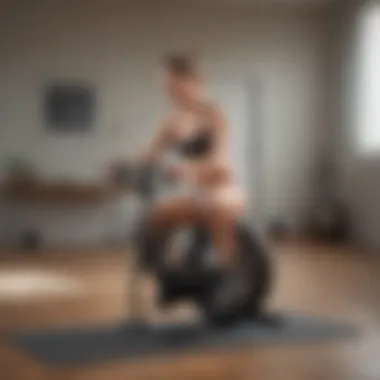Exploring the Floor Cycle Exerciser: A Comprehensive Guide


Intro
The floor cycle exerciser stands out as a remarkable tool in the fitness landscape. With design focused on efficiency and compactness, it caters to users across various fitness levels. This guide will take an in-depth look at how this device works and its multiple benefits that go beyond traditional exercise equipment.
Incorporating the floor cycle exerciser into your routine can transform your approach to fitness. Notably, it offers the luxury of improving health from the comfort of your home, appealing to those who seek practicality without compromising results.
Through this article, you will gain insights into the design aspects, functional mechanisms, and effective applications of floor cycle exercisers in daily life. We will methodically explore its key benefits, practical tips for usage, and best practices to optimize results. Each section aims to equip professionals in the fitness and wellness fields with knowledge to better serve their clients or implement personal strategies.
This resource will be particularly beneficial for health professionals, wellness coaches, nutritionists, fitness trainers, and mindfulness instructors seeking to enhance their understanding and optimization of physical activity tools.
Understanding the Floor Cycle Exerciser
The floor cycle exerciser represents a growing trend in fitness, where compactness meets functionality. It is essential for potential buyers and users to understand how these devices operate, their diverse designs, and their overall benefits. In an era where space is often limited, the floor cycle exerciser provides a practical solution for maintaining physical fitness. Grasping the fundamental aspects of this equipment encourages informed decision-making, enabling users to integrate the exerciser effectively into their routines.
Definition and Functionality
A floor cycle exerciser is a small, portable device designed for cycling in a seated position. Unlike traditional bicycles, which require outdoor space and can be cumbersome, the floor cycle allows for efficient workouts indoors. The primary function is to improve cardiovascular health, enhance muscle tone, and facilitate low-impact exercise.
The contrivance operates by mimicking the pedaling action of a bicycle. Users pedal in a relaxed position, often while working at a desk or watching television. This capacity to multitask enhances its appeal for busy individuals seeking to incorporate physical activity into their daily lives. The versatility of the floor cycle exerciser makes it suitable for rehabilitation, home fitness, and general exercise.
Design Variations
Floor cycle exercisers come in various designs, which cater to different preferences and functionalities. These variations include:
- Compact Versions: These small units are designed to fit under desks or in small spaces, making them ideal for home use. They prioritize portability and lightweight structures.
- Adjustable Resistance Models: Some exercisers offer adjustable resistance levels to cater to different intensity needs. Users can increase or decrease resistance, providing a customizable workout for various fitness levels.
- Integrated Display: Some models feature a built-in display to track time, distance, and calories burned. This information allows users to monitor their workouts effectively and stay motivated.
The diversity in design plays a crucial role in reach and accessibility, appealing to a broader audience. This variety ensures that users can select a model that fits their unique needs, enhancing the overall experience and effectiveness of the exerciser.
Mechanics of Operation
Understanding how the floor cycle exerciser operates is critical for both users and trainers. Operation is straightforward and usually involves the following components:
- Pedals: Designed for comfortable foot placement, most have straps or grips to secure the user's feet while pedaling, ensuring safety.
- Flywheel Mechanism: Many units are equipped with a flywheel that provides smoother pedaling motion. This mechanism helps to simulate outdoor cycling and reduce noise during use.
- Resistance System: Depending on the model, it may utilize magnetic or friction-based resistance for controlled intensity. Users adjust this feature to enhance or lessen the workout challenge.
- Ergonomic Design: The positioning of the pedals and frame is crucial for promoting proper posture and reducing strain on the back and joints. An ergonomic structure facilitates a more comfortable and efficient workout.
In summary, the mechanics contribute significantly to the user experience, emphasizing the importance of selecting an appropriate model. Understanding these elements aids in achieving optimal exercise results and maximizing the benefits of the floor cycle exerciser.
Benefits of Using a Floor Cycle Exerciser
The floor cycle exerciser offers significant advantages for individuals aiming to enhance their fitness levels. These compact machines facilitate various exercises that cater to different fitness goals. Unlike larger fitness equipment, floor cycle exercisers fit seamlessly into many spaces, making them accessible to a wider audience. This section outlines the key benefits, covering aspects like cardiovascular health, muscle engagement, and calorie burn.
Cardiovascular Health
Utilizing a floor cycle exerciser can markedly improve cardiovascular health. Regular use elevates the heart rate, promoting better blood circulation and overall heart function. The continuous motion of pedaling strengthens the heart muscle and enhances endurance. This type of exercise is particularly beneficial for individuals who may have limited mobility or find traditional cardio workouts challenging. Research indicates that incorporating low-impact exercises such as cycling can lead to lower blood pressure and improved heart health over time. Engaging with this device consistently can contribute to long-term cardiovascular benefits.
Muscle Engagement
The floor cycle exerciser engages various muscle groups effectively. Primarily, it targets the legs, including the quadriceps, hamstrings, and calves. However, depending on the intensity and style of pedaling, it can also engage core muscles as users stabilize themselves while cycling. This engagement helps in building strength and improving muscle tone. Unlike exercises that isolate specific areas, floor cycling promotes overall body coordination and functional fitness. For fitness trainers and wellness coaches, emphasizing this aspect can encourage users to incorporate floor cycling into their routine as a fundamental strength-building exercise.
Calorie Burn and Weight Management
Effective calorie burning is a central feature of using a floor cycle exerciser. Depending on the intensity and duration of the workout, users can burn a considerable number of calories. This capability is vital for those aiming for weight loss or management. It offers a practical way to combine exercise with calorie expenditure without the need for high-impact movements, making it suitable for various fitness levels. Moreover, integrating this machine into a balanced fitness regimen can help maintain body weight and foster a healthy lifestyle.
Regular usage leads to notable weight management and overall increased aerobic fitness.


Emphasizing these benefits when discussing the floor cycle exerciser can help draw in health professionals and fitness enthusiasts alike. Its ability to deliver substantial cardiovascular support, muscle engagement, and effective calorie burning positions the floor cycle exerciser as a valuable tool in any fitness arsenal.
Incorporating the Floor Cycle Exerciser into Your Routine
Incorporating the floor cycle exerciser into your routine can significantly enhance your overall fitness experience. This compact piece of equipment offers tailored solutions for individuals aiming to improve their cardiovascular health and engage in effective strength training. Adaptability is one of its key advantages; it can fit seamlessly into various lifestyles and fitness levels.
Effective Workouts
Developing effective workouts with a floor cycle exerciser involves understanding personal fitness goals. Whether aiming for endurance training or muscle toning, the exerciser can cater to both. Here are some guidelines to optimize workouts:
- Warm-up: Start with a 5 to 10-minute light pedaling to prepare your muscles and joints.
- Interval Training: Incorporate high-intensity interval training (HIIT) by alternating between periods of intense pedaling and recovery. For example, sprint for 30 seconds, followed by 1 minute of slow pedaling.
- Endurance Riding: Aim for longer sessions at a moderate pace to build stamina. Approximately 20 to 30 minutes can yield great benefits.
- Strength Training: Modify resistance settings to engage different muscle groups. Increase resistance to focus on leg strength.
These sessions can vary based on individual preferences, making them enjoyable and effective.
Frequency and Duration Guidelines
The effectiveness of any exercise routine relies on consistent practice. For the floor cycle exerciser, aiming for at least 3 to 5 sessions per week is advisable. Each session should last between 20 to 45 minutes, depending on your fitness level and goals. Here are some recommendations:
- Beginners: Start with 15 to 20 minutes, three times a week, gradually increasing duration.
- Intermediate: 25 to 30 minutes, four to five times a week can help solidify momentum.
- Advanced: 40 to 60 minutes, incorporating more intense workouts or additional resistance.
This structure encourages gradual progression, promoting sustainable improvement without overwhelming the body.
Combining with Other Exercise Forms
Combining the floor cycle exerciser with other forms of exercise can yield comprehensive benefits. Integrating activities such as strength training or flexibility exercises can lead to a balanced fitness regimen. Consider these strategies:
- Cross-Training: Use the floor cycle on alternate days with activities like yoga or weightlifting. This approach protects against overuse injuries while enhancing overall fitness.
- Core Workouts: Add core stability exercises such as planks or Russian twists immediately before or after cycling workouts. This inclusion helps build core strength, essential for supporting cycling motions.
- Flexibility and Recovery: Post-cycling stretching routines can improve flexibility and aid recovery. Including yoga or dedicated stretching sessions benefits long-term performance.
By varying routines, individuals can keep the workouts fresh and also target different muscle groups effectively.
Target Audience and Suitability
Understanding who can benefit from the floor cycle exerciser is essential for maximizing its value in different fitness journeys. With the rise of compact fitness solutions, this tool appeals to a diverse range of users. Notably, the floor cycle exerciser is designed for those who have limited space but still seek effective workouts. Its convenience makes it suitable for various demographics, including busy professionals, seniors, and even fitness enthusiasts who aim to diversify their routines.
Who Can Benefit
- Busy Professionals: Individuals who work long hours and find it hard to allocate time for gym visits can greatly benefit from this equipment. They can easily fit short sessions throughout their day while working from home or even while watching television.
- Seniors: As mobility can decline with age, a floor cycle exerciser offers a low-impact way to engage in cardiovascular exercise without stressing the joints. It allows seniors to build strength and endurance at their own pace.
- Rehabilitation Patients: Those recovering from injuries or surgeries can utilize the floor cycle to engage muscles gently. This allows controlled movement that encourages recovery while avoiding excessive strain.
- Students: College students with limited budgets and small living spaces can also take advantage of this portable fitness option. They can pursue their fitness goals without needing large equipment or a gym membership.
Adaptations for Different Fitness Levels
The versatility of the floor cycle exerciser extends to different fitness levels, making it adaptable to anyone's needs. Here’s how it caters to various users:
- Beginners: Individuals just starting their fitness journey can begin with light resistance and shorter workout durations. This gradual approach ensures they can build confidence and endurance without intimidation.
- Intermediate Users: Those with a moderate fitness background can introduce higher resistance settings, enhancing their cardiovascular workout. They can also experiment with varying pedaling speeds to challenge themselves further.
- Advanced Fitness Enthusiasts: For seasoned fitness lovers, the simplicity of the exerciser can still deliver intense workouts. Interval training can be conducted effectively, alternating between high and low intensities to maximize calorie burning.
Comparative Analysis with Other Fitness Equipment
Understanding how the floor cycle exerciser compares to other types of fitness equipment is vital for consumers and fitness enthusiasts alike. This section delves into its relative advantages and considerations against common alternatives. By examining the distinctions of the floor cycle in contrast to traditional bicycles, stationary bikes, and treadmills, readers will develop a clearer picture of where this equipment stands in the fitness landscape.
Floor Cycle vs. Traditional Bicycles
The floor cycle exerciser offers a different experience than traditional bicycles, which are designed for outdoor use. One key advantage of the floor cycle is its convenience. Users can engage in exercise at home regardless of weather conditions. Traditional bicycles have a risk element when used on roads, exposing riders to traffic accidents and weather variations. In contrast, floor cycles provide a safe alternative, allowing for uninterrupted workouts.
Another aspect is the functionality offered by floor cycles. They are typically compact and can fit into small spaces, making them a practical choice for home workouts. Traditional bicycles require storage space and are less portable. While outdoor cycling promotes different muscle engagements due to varied terrains, floor cycles can offer more consistent resistance and allow users to pedal at their own pace with less risk of injury.
Floor Cycle vs. Stationary Bikes


When comparing floor cycles to stationary bikes, the difference can seem subtle at first. Both are found commonly at home and gyms. However, old models of stationary bikes were often bulky and limited in movement. The floor cycle often has a smaller footprint and can resemble an ergonomic chair, encouraging prolonged use without discomfort.
The adaptability of the floor cycle also deserves mention. Many modern floor cycles allow for adjustable resistance, providing options that stationary bikes may not. Users can tailor their workouts with more precision, ensuring they are targets of specific fitness goals. It's important to note that the floor cycle also engages the upper body more effectively with certain models, providing a comprehensive cardio workout that stationary bikes might miss.
Space Efficiency Compared to Treadmills
Space constraint is a significant consideration for many fitness buffs. Treadmills provide excellent cardiovascular workouts but demand considerable space. Floor cycle exercisers are notably space-efficient. They can often be stored under a bed or in a closet, making them a suitable choice for smaller homes or apartments.
In urban areas where square footage is limited, residents searching for fitness equipment would benefit from using a floor cycle. The compact nature not only saves room but encourages more consistent daily use. In contrast, some people might find it difficult to justify setting up a treadmill, which often dominates the space.
"Compactness can significantly enhance the likelihood of engaging in regular exercise."
Safety Measures and Precautions
Safety is a crucial aspect when using a floor cycle exerciser. Proper precautions ensure a safe and effective workout experience. Neglecting safety can lead to injuries and equipment malfunction, which detracts from the main goal of enhancing physical fitness. Understanding safety measures will not only protect the user but also prolong the equipment's life. Users should always adopt safe practices, which promotes consistent workout sessions and optimal gains.
Proper Use Guidelines
To use a floor cycle exerciser safely, users should follow certain guidelines:
- Check Equipment Before Use: Ensure the exercise bike is assembled correctly and securely. Loose parts can result in accidents.
- Adjust the Seat and Pedals Correctly: Proper adjustment reduces the risk of strain and injury. Users should set the seat height to allow a slight bend in the knees.
- Start Slowly: Beginners must ease into workouts. Overexerting at the start can lead to strains or joint issues.
- Maintain Good Posture: Keeping the back straight and engaging the core while cycling is important. This helps to avoid injuries related to poor posture.
- Stay Hydrated: Drinking water before, during, and after workouts assists in preventing dehydration.
- Use Non-Slip Footwear: Proper footwear will help maintain grip on the pedals, decreasing the risk of slipping.
Common Injuries and How to Prevent Them
While the floor cycle exerciser is generally safe, some common injuries can occur if proper precautions are not taken. Here are a few:
- Knee Pain: Often results from improper seat height or overuse. To prevent it, make sure to adjust the seat correctly and build up intensity gradually.
- Lower Back Strain: Poor posture can lead to strain. Always monitor your body alignment while cycling and take breaks if necessary.
- Ankle Strain: Overextending the pedaling motion or using incorrect footwear can cause this. Using supportive shoes and maintaining a proper stroke technique helps avoid this issue.
To mitigate these risks, users should consider:
- Engaging in a warm-up routine before workouts.
- Gradually increasing intensity and duration of workouts.
- Listening to one’s body; if an exercise causes pain, it is wise to stop.
"Safety measures are not just rules; they are the foundation of effective fitness practices."
By adhering to proper use guidelines and being aware of common injuries, users can enjoy the benefits of the floor cycle exerciser while minimizing risks.
Maintenance of Floor Cycle Exercisers
Maintaining a floor cycle exerciser is crucial for ensuring its longevity and optimal performance. Proper maintenance not only enhances the user experience but also significantly reduces the risk of injuries associated with faulty equipment. Regular attention to this compact fitness tool can preserve its mechanical integrity and ensure a safe exercising environment. Exercisers that are well cared for offer consistent performance metrics and a more enjoyable workout experience.
Routine Checks and Cleaning
Establishing a routine for checks and cleaning is imperative for any equipment, especially for one that bears the weight of daily usage like a floor cycle exerciser. Maintaining its cleanliness is essential for hygiene, particularly since users often sweat during their workouts. Here are key aspects to focus on:
- Visual Inspection: Regularly inspect the frame and components for any signs of wear and tear, rust, or loose parts. This helps in identifying potential issues before they escalate.
- Cleaning the Surface: A damp cloth can effectively clean the external surfaces. Users should avoid using harsh chemicals as they may damage the finish.
- Inspecting the Resistance Mechanism: Examine the resistance settings to ensure they function smoothly. Any sticking could indicate a need for lubrication.
- Checking Pedal Stability: Ensure that the pedals are secured tightly. Loose pedals can cause unsafe conditions and an ineffective workout.
- Wiping down After Use: Implement a habit of wiping down the exerciser after each session to maintain its cleanliness and performance.
Troubleshooting Common Issues
Even the best equipment can face issues over time. Knowing how to troubleshoot these problems can save time and money. Here are some common problems and their solutions:
- Resistance not Functioning Properly: Ensure that the resistance knob is adjusted correctly. If issues persist, there could be a mechanical problem that requires professional attention.
- Sounds During Use: Unusual sounds can signal a need for lubrication or indicate that parts are too tight or misaligned. Users should check all moving parts for proper alignment and stiffness.
- Bike Moves During Use: This might happen due to an uneven surface. Adjust the exerciser to ensure all legs are even.
- Pedals Slipping: This can happen when pedals are not tightened correctly. Check the connections to ensure everything is secure. If the problem persists, the pedals may need to be replaced.
Incorporating these simple maintenance practices can prolong the lifespan of a floor cycle exerciser, ensuring that it remains a valuable component of any fitness routine.


Cost Considerations
Evaluating the cost of a floor cycle exerciser is essential for potential buyers. Fitness equipment can vary greatly in price, often reflecting the quality, features, and brand. Understanding these costs can help users make an informed decision that aligns with their budget and fitness goals. The price also correlates to the longevity, functionality, and overall performance of the product. In a landscape where fitness trends continuously evolve, finding a cost-effective solution is vital for sustained engagement and success in fitness routines.
Budget-Friendly Options
For those who are price-sensitive, there exist several budget-friendly floor cycle exercisers. These models often offer essential functions without luxury features that can drive up the cost. When shopping for affordable options, consider:
- Basic Resistance Settings: Many budget models come with adjustable resistance to meet various levels of intensity, which is essential for usability and engagement.
- Frame Stability: Ensure the unit provides enough stability and durability for longer workouts, even in lower-priced models.
- Compact Design: Look for designs that do not occupy much space yet support a comfortable riding position.
Some notable budget-friendly models include the Sunny Health & Fitness SF-B0418, which provides a solid cycling experience without excessive features, making it ideal for beginners.
Premium Models Overview
Consumers seeking high-end floor cycle exercisers can find models that incorporate advanced features to enhance usability and performance. Premium options frequently come with:
- Advanced Technology: Models like the Lifespan Fitness C3i include smart technology that aids in tracking performance metrics such as distance, speed, and heart rate.
- Enhanced Comfort: Many high-end models provide ergonomic designs, including padded seats and adjustable handlebars for an individualized riding experience.
- Durability: Premium models are typically built with stronger materials that ensure longevity and consistent performance during intense workouts.
These features justify the higher price point for users looking to invest in their fitness journey. When purchasing, it’s essential to weigh these features against cost to determine whether the added investment aligns with fitness objectives.
User Reviews and Testimonials
User reviews and testimonials offer valuable insight into the real-world performance and user experience of floor cycle exercisers. These firsthand accounts provide information that goes beyond marketing claims and specifications, helping prospective buyers make informed choices. Understanding user sentiments can aid in recognizing the strengths and weaknesses of different models.
When exploring floor cycle exercisers, feedback from users is important for a few reasons. First, it highlights various experiences that users have encountered while utilizing these machines. Some users may discuss their fitness goals, such as weight loss or improved endurance, which can relate directly to the efficiency of the exerciser. Additionally, reviews may cover the ease of assembly, durability, and level of comfort, helping potential users assess if the product meets their needs. Reviews also often reflect the customer service experience, which can be a critical factor when purchasing fitness equipment.
General Sentiment and Feedback
Overall, user feedback on floor cycle exercisers tends to provide a balanced perspective on their performance. Most reviews reveal a positive sentiment regarding their compact design and functionality. Many users appreciate the convenience they offer, especially for those with limited space at home. The reviews frequently highlight the versatility of workouts that floor cycle exercisers facilitate. Users often emphasize that these machines can accommodate various fitness levels, making them suitable for a wider audience.
On the other hand, some negative feedback does exist. A few individuals mention discomfort during extended sessions or instances of mechanical issues. This can signal the importance of selecting a well-reviewed model. Analyzing testimonials allows potential buyers to weigh these aspects thoroughly before making a purchase.
"The floor cycle has transformed my exercise routine. I love the convenience it offers while watching TV! However, I did encounter some early issues with the knob adjustment." - A satisfied user
Case Studies of Successful Users
Examining case studies of successful users can provide informative examples of how to effectively integrate a floor cycle exerciser into a fitness regimen. For instance, Sarah, a busy professional, managed to incorporate daily sessions into her lifestyle. She noticed improvements in her cardiovascular endurance and daily energy levels within just a few weeks.
In another example, Mike, who struggled with gym anxiety, found the floor cycle a less intimidating option for home workouts. His consistent use led to significant weight loss and increased confidence in his fitness journey. These success stories highlight the transformative potential of floor cycle exercisers when used regularly.
Furthermore, many users have creatively combined their workouts with other activities. From enjoying a book to watching online classes, they demonstrate that the versatility of the floor cycle can enhance not only physical health but also overall well-being. The narratives crafted by these individuals present a tangible understanding of how the floor cycle exerciser fits into varied lifestyles, thereby underscoring the importance of real user experiences.
Future Trends in Home Fitness Equipment
The landscape of home fitness is continuously evolving, driven by technology and changing consumer behaviors. Staying informed about future trends is crucial for health professionals, wellness coaches, nutritionists, fitness trainers, and mindfulness instructors. These insights help them adapt their practices and meet the growing demands of fitness enthusiasts. Not only do trends reflect the public's preferences, but they can also inform strategies to enhance user experience and outcomes. This section highlights the key advancements that are shaping the future of fitness equipment, focusing specifically on floor cycle exercisers and their role in modern routines.
Technological Innovations
One of the most significant trends in home fitness is the rapid advancement in technology. Smart fitness equipment, including floor cycle exercisers, are becoming equipped with sophisticated features. These innovations often include:
- Integrated tracking systems that monitor performance metrics such as calories burned, distance covered, and heart rate.
- Interactive training sessions through app connectivity, allowing users to engage with virtual classes and trainers.
- Customizable settings that adjust resistance levels and workout intensity according to personal fitness goals.
These technological enhancements not only provide users with real-time data but also create a more engaging workout experience. Fitness professionals can leverage these tools to analyze their clients' performance, thus offering tailored recommendations and improving overall results. Moreover, the shift toward smart equipment ensures that users remain motivated and accountable, promoting adherence to exercise routines.
Sustainability in Fitness Equipment
Sustainability is another critical aspect driving future trends in home fitness. Environmentally conscious consumers are increasingly demanding sustainable products, and the fitness industry is responding accordingly. Here are some considerations:
- Eco-friendly materials: Many manufacturers are exploring the use of recycled materials in their products, reducing waste and environmental impact.
- Energy-efficient designs: New floor cycle exercisers are being designed to consume less energy, which is appealing in an age where energy conservation is paramount.
- Durability and longevity: Sustainable fitness equipment emphasizes long-lasting quality, reducing the need for frequent replacements.
By choosing sustainable fitness equipment, users can contribute to a healthier planet while achieving their personal wellness goals. Health professionals can educate their clients on the importance of sustainability in their fitness choices, fostering a community that values both health and the environment.















